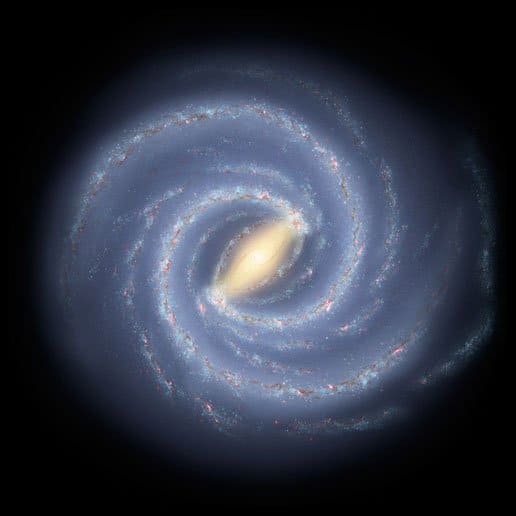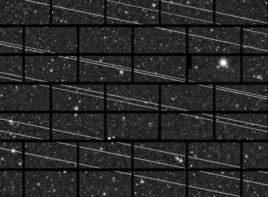
Some physicists believe that changes to the Earth’s climate can be explained in large part by variations in the flux of cosmic rays reaching the Earth. These occur as the solar system pass in and out of our galaxy’s spiral arms — passages that seem to correlate closely with the timing of ice ages. However, new research based on a recent model of the structure and motion of the spiral arms finds there is no such correlation.
In 2003 physicists Nir Shaviv and Ján Veizer reported a close correlation between the motion of the solar system through the Milky Way and changes to the Earth’s climate. They found that the solar system passes through one of the galaxy’s four spiral arms about once every 140 million years, and these intersections correspond with both the peaks of successive ice ages and fluctuations in the abundance of oxygen-18 in fossils — which is related to temperature. Both climatic variables also vary with a period of about 140 million years.
To explain such a link, the researchers note that higher rates of local supernovae should lead to greater fluxes of cosmic rays as the solar system passes through the Milky Way’s spiral arms, which are higher-density regions of stars and gas within the galaxy. Physicist Henrik Svensmark has proposed that the secondary particles created by these cosmic rays as they pass through the atmosphere can help the formation of condensation nuclei for clouds, with the increased formation of low clouds blocking more sunlight and hence cooling the Earth. This hypothesis has proved controversial, given its implications for our understanding of global warming.
Now, physicists Adrian Melott and Andrew Overholt of the University of Kansas and Martin Pohl of Iowa State University in the US have carried out a new study of the supposed link between the solar system’s galactic motion and climate change and have found that the correlation does not exist.
New view of the Milky Way
They base their work on a new model of the galaxy produced last year by astronomer Peter Englmaier, who used the distribution of carbon monoxide molecules throughout the Milky Way, as revealed in infrared data collected by NASA’s Spitzer mission, to trace out the structure of the spiral arms. Englmaier found that the arms branch off at varying angles to one another and that the galaxy therefore has quite an asymmetrical shape.
In using this model to work out when the Sun intersects the galactic arms, Melott’s group also needed to know how quickly the spirals move (the speed of the solar system itself is well known). The spiral pattern propagates through the galactic material much as a sound wave propagates through air, and its speed of propagation is found out by measuring the speed with which newly born star clusters move away from the spiral arms where they are created.
Combining this speed data with the asymmetric position of the spirals in Englmaier’s model, the researchers found that the distance and therefore time between successive intersections of the solar system with spirals was not constant, and that there was therefore no correlation with ice ages on Earth. They discovered that this result held up across a wide range of pattern propagation speeds.
What about the galactic plane?
Pohl points out that, strictly speaking, this research only rules out a correlation between climate and spiral-arm passages, and that there has been speculation that the motion of the Sun in and out of the galactic plane could have effects on Earth.
Svensmark, however, believes the spiral–arm correlation itself still stands. He says the analysis by Melott and co-workers has problems in determining the location of spiral arms and also wrongly assumes that the whole spiral-arm pattern moves with a single speed. ““This latest work does not make me reconsider the link between galactic dynamics and the climate on Earth,” he added.
The research is reported on arXiv.



